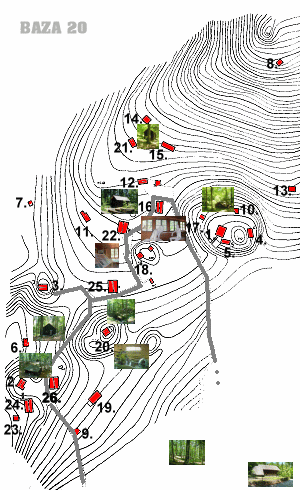 Kočevski
Rog - the name describes over 500 square kilometres of hilly cars area
situated between Kočevje - Ribnica valley, Suha krajina, Novo mesto basin
and Bela krajina. Due to its impassability, deep forests and harsher clime
it was not settled before the 14th century when it was colonised by
settlers of German nationality. At the beginning of the 2nd World War,
after attack on Yugoslavia in 1941, this area was occupied by Italy and
during the winter 1941/42 all Germans of Kočevje area were relocated to
lower Posavje region, (which was under German occupation), into the homes
of over 36.000 previously deported Slovenians. Over 40 Rog villages and
settlements remained empty after this German emigration.
Kočevski
Rog - the name describes over 500 square kilometres of hilly cars area
situated between Kočevje - Ribnica valley, Suha krajina, Novo mesto basin
and Bela krajina. Due to its impassability, deep forests and harsher clime
it was not settled before the 14th century when it was colonised by
settlers of German nationality. At the beginning of the 2nd World War,
after attack on Yugoslavia in 1941, this area was occupied by Italy and
during the winter 1941/42 all Germans of Kočevje area were relocated to
lower Posavje region, (which was under German occupation), into the homes
of over 36.000 previously deported Slovenians. Over 40 Rog villages and
settlements remained empty after this German emigration.
The first units of National Liberation Movement moved into Rog area during
Avgust of 1941. During May of 1942 a large territory of Dolenjska,m
Notranjska and Bela krajina was liberated and Rog became the centre
of resistance. The Slovenian Partisan Army Command was located at Kraljevi
kamen location until Avgust of 1942. After a large Italian offensive
during the summer of 1942 the National Liberation Movement Command moved
to Polhograjski Dolomiti and designated the Rog area for Partisan
hospitals, workshops, schools, printing works and warehouses.
The Slovenian Partisan Command returned to Rog on 17th of April of 1943.
The new location was code named BAZA 20. It has become a home and a
working place for members of Liberation Front Executive Committee,
Liberation Front Plenum, Slovene Communist Party Central Committee,
Propaganda nad Agitation Commission, editors of different partisan
newspapers and publications and members of Antifascist Council of Yugoslav
National Liberation (AVNOJ). The Protection Battalion fighters, as well as
the technical staff, were in charge of safety and procurement. In all 26
wooden barracks were erected nad settled until December of 1944 when
the last of their inhabitants moved to Črnomelj. A permanent exposition
located in Barrack
No. 16 of BAZA 20 represents its significance and role.
|
text:
Jože Saje |
A
permanent exibition presenting a variety of partisan activities in Kočevski
Rog can be seen in Barack
No. 22 in BAZA 20. BAZA 20 and Jelendol and Zgornji Hrastnik hospitals
are the only remaining partisan sites preserved and are declared as
national cultural monuments.
Phone.: (+ 386) 050-63-31-54